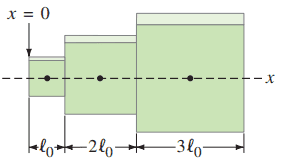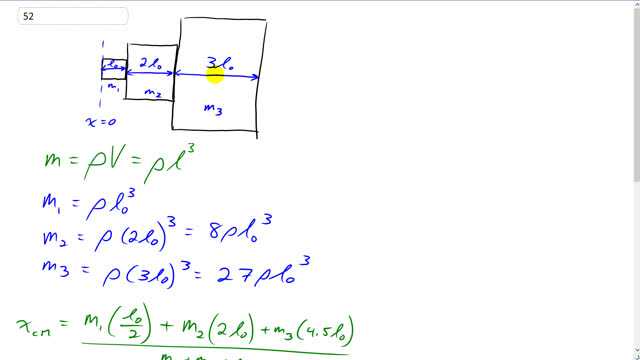
Three cubes, of side , , and , and are placed next to one another (in contact) with their centers along a straight line as shown in Fig. 7–38. What is the position, along this line, of the CM of this system? Assume the cubes are made of the same uniform material.


In order to watch this solution you need to have a subscription.
This is Giancoli Answers with Mr. Dychko. We are going to find the center of mass of these three cubes and we can consider each cube to be a point mass where this cube exists just here at this point at its center of mass and this cube is here at this point and this cube here is at this point. So we'll take the center of mass as being the mass of the cube multiplied by the distance of the cube center of mass from this reference point here x is 0. Now we need to figure out the mass of each cube and the mass of any of them is gonna be its density multiplied by its volume so that will be density times the side length of the cube cubed. So for this first block here, its mass is gonna be m 1 equal to density times l naught cubed— the side length is l naught— and for m 2, its gonna be density times its side length which is 2 l naught cubed which makes 8ρl naught cubed. And then m 3 is gonna have a mass of density times 3l naught and 3 cubed is 27 so we have 27ρl naught cubed. So the center of mass is gonna be the mass of each block so in the case of block one, m 1, we are gonna substitute ρl naught cubed in place of m 1 in a second but let's start with by saying m 1 times the distance from that particular cube's center of mass to the reference point, x equals 0, and that distance will be l naught over 2 because the center of mass of this particular block will be half way because it's uniform density—it's gonna be right in the middle—so l naught over 2. And then for block two, it's gonna be here which is at the center of this cube and since it has a length of 2l naught, the center is gonna be a distance of 1l naught from the edge here and then a further l naught from the reference point so that gives 2l naught is gonna be the distance and multiply by m 2 and then plus m 3 times 4.5l naught because this point here is gonna be 3 over 2 times l naught from this edge of the cube which is 1.5l naught and then plus an additional 2 plus an additional 1 so that's 3 plus 1.5 is 4.5l naught and all of that gets divided by the total mass so then in the next line, we substitute for the masses. So we have 0.5 is the same as one-half 0.5 times ρl naught cubed for m 1 times l naught and then we have 2 times 8ρl naught cubed for m 2 times l naught and then we have 4.5 times 27ρl naught cubed times the l naught here and then on the bottom, we drew those substitution's for the masses as well and conveniently, ρl naught cubed cancels from every one of these terms and make sure that when you cancel this guy, you still keep the 1 behind, it doesn't mean it makes 0, it just means that we are dividing everything by this term and so ρl naught cubed divided by ρl naught cubed is 1. And then what we plug into our calculator is 0.5 plus 16 plus 121.5 all divided by 1 plus 8 plus 27 and that gives 3.8 and that's multiplied by l naught and that is the position relative to the left hand block position x equals 0 of the center of mass of a system of three blocks.